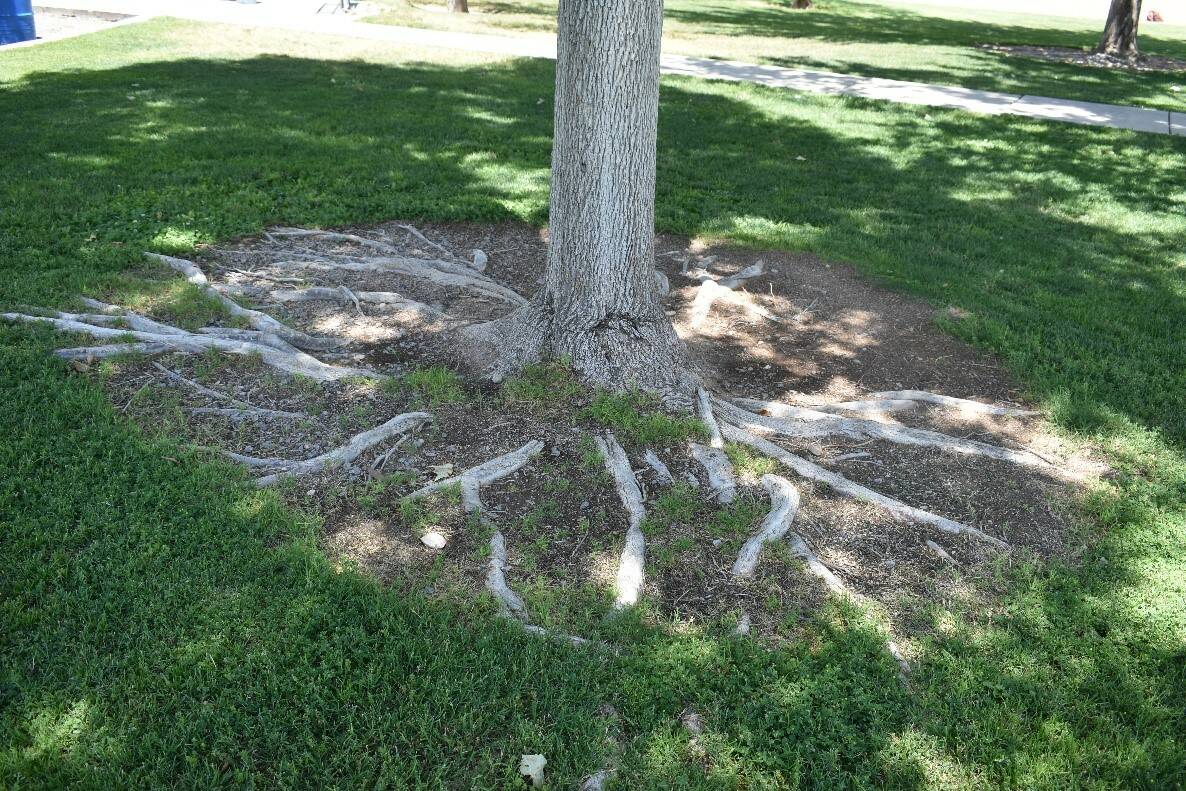Treet roots follow water, so application should be at base
Q: I have two trees that were planted some 15 years ago improperly as the lawn sprinklers were used for watering instead of drip. The roots are spreading in all directions, and I am worried they may damage the home foundation, patio and possibly sewer lines down the road. Are there any tree root solutions?
A: The roots of plants follow water. Where water was applied, you will find roots. If they have not received water for at least a year, then they may be dead.
Apply water to the base of the tree to about 2 or 3 feet in all directions. That should be enough water to stabilize 20-foot to 30-foot trees. If they are taller than that, then you may need to apply water to a wider area than that.
If the roots are unsightly then have them removed (cut) in about one year. Give any existing roots a chance to re-establish closer to the tree first.
If the existing roots can be covered with rock, apply about 2 to 3 inches of rock as surface mulch. Otherwise, consider woodchips. I would suggest putting a quarter-inch layer of compost underneath the rock where water is applied.
Q: I saw your blog about problems with their Italian cypress trees. I thought that might be good for my small backyard but, according to your article, this is not a good thing. So, what does work well?
I live in the Henderson area. I have a midsized backyard, and the trees are just taking a beating this summer. Even last summer they really don’t look that good. What can you suggest that won’t get too big and will have some color? I don’t want something bigger than my wall (less than 4 feet).
A: The problem I have with Italian cypress planted in home yards is its size. At 40+ feet tall, they can get big. They are more suitable for resorts like Caesars Palace and larger-scale landscapes.
I can’t give you a list of plants, but I can tell you what to look for. If I give you a list of plants, we could go back and forth several times before you find something you like. It is best to see what is available from your sources.
First, you want something that comes from a desert. Those kinds of plants will usually take the heat and lower water use.
You said that you wanted plants no taller than 4 feet, but you didn’t say how wide. Don’t trust the first salesperson you meet. They may not know their plants. Ask several people in the nursery for their opinions on the plant that you like.
Q: One of my Japanese blueberries is dying. It’s the only one that is facing south and is in full sun all day long. It has dropped all its leaves and I’m thinking I should replace it with a native tree that can take full sun and heat.
Do you have any thoughts on what would be a good tree to put there? Both of our bottle trees did fine in the heat this summer, but I know you thought it was a little crazy for us to put trees in our backyard that will grow to be 50 feet.
Would a palo verde be a good choice? We need a tree that grows to about 10 feet and can take full sun. And since it’s essentially in a planter (5-foot wall behind it and 3-foot wall in front of it), I would need something with noninvasive roots.
A: Japanese blueberry does well in arid parts of Japan but not in the direct sunlight of the desert. There are smaller trees from the desert than either the bottle tree or palo verde.
I think what you’ll need is a tree from the desert Southwest. What comes to mind are Texas mountain laurel, desert willow, some of the smaller acacia and mesquite, etc.
Keep them small. Both the bottle tree and palo verde are quite large and don’t fit the under-10-foot rule that you’ve established. Even vitex, a blue flowered Mediterranean tree or European olive, would be a better choice even though they are about 20-25 feet tall.
If you’re looking for a replacement tree, remember that in the desert it should have a purpose for being there. Otherwise omit and replace it with something that doesn’t use water and is still interesting to look at such as wall murals, garden art, gazebo, etc. Don’t replace it with something that absorbs and releases heat slowly at night such as a cement driveway.
Q: Our HOA landscapers cut off the red shoots of our red yucca this week. Is this, OK? Have I lost the beauty of the plant?
A: I’m hoping that your HOA landscape maintenance people only cut the flowering parts of red yucca on HOA property. These flowering parts are cut off so that none of the flower stalk shows. They will flower again next year and look fine. If they cut the spiky leaves, then it will take several years for the leaves to be replaced.
Red yucca needs to be dug up and divided about every five years. It’s time to dig them up and divide them when flowering comes from the edges of the plant. Flowering from the perimeter of signals it is time to divide them.
Q: How deep do oleander roots go?
A: If you are asking concerning irrigation then root depth depends on the bush’s height. The oleanders that are red or white (about 18 feet tall) are irrigated to a depth of 18 to 24 inches while the dwarf salmon-colored oleanders (4 to 5 feet tall) are irrigated from 12 to 18 inches deep.
If these oleanders are on the same valve, then the red or white ones should have about four to six drip emitters while the dwarf types have two to four of the same type of drip emitters.
The closest drip emitters are spaced about 12 inches from the trunks of the bushes and deliver water to about half the area under their canopies. The length of time the drip emitters deliver water depends on the size of the emitters and the soil texture. They deliver water long enough to wet the roots 12 to 24 inches deep.
This water is delivered normally all at once. This might vary from one to three hours.
It does not hurt the plant to water deep, it just wastes water. Plant harm comes from watering the plant too often.
Q: I planted a Fantasia nectarine tree in my front yard last March. The heat in the summer of 2022 was brutal, and the leaves yellowed and were off by early August. It shocked me with green leaves but only at the base. The top branches were bare, but not brittle and dead. Any advice on keeping this alive? Should I prune off all of the top branches?
A: Pruning off all the top branches just makes the trunk more exposed to direct sunlight. Direct sunlight or sun damage can attract female egg-laying adults.
Nectarine trees are identical to peach trees. Peach trees have short lives, most likely because of damage from borers.
Leave lower limbs attached to the trunk and as low as possible. Do not remove them unless they are interfering with tree growth. The lower limbs provide shade to the trunk of the tree. That may be important for borer control. Remove the lower limbs as the tree gets older, don’t do it while it’s young.
Make sure the nectarine tree has water that wets the roots to a depth of 18 to 24 inches each time you water. During the summer water may need to be applied to the soil three to four times each week in all but the sandiest soils.
Try to give the trees one day between applications of water. As the tree gets larger, the area where water is applied also has to get larger. Add drip emitters to the irrigated area every three to four years until the tree reaches the size you want. Controlling the size is done every winter pruning.
Surface mulch is important for controlling moisture in the soil. Two to 3 inches of surface mulch gives you an extra day of water during the summer. It is best to use woodchips because they add organics to the soil as they rot. Fruit trees need about 2 to 4 percent organic matter in the soil to grow best. Rotting woodchips will add that. Otherwise, plan on adding it to the soil yourself.
Bob Morris is a horticulture expert and professor emeritus of the University of Nevada, Las Vegas. Visit his blog at xtremehorticulture.blogspot.com. Send questions to Extremehort@aol.com.























